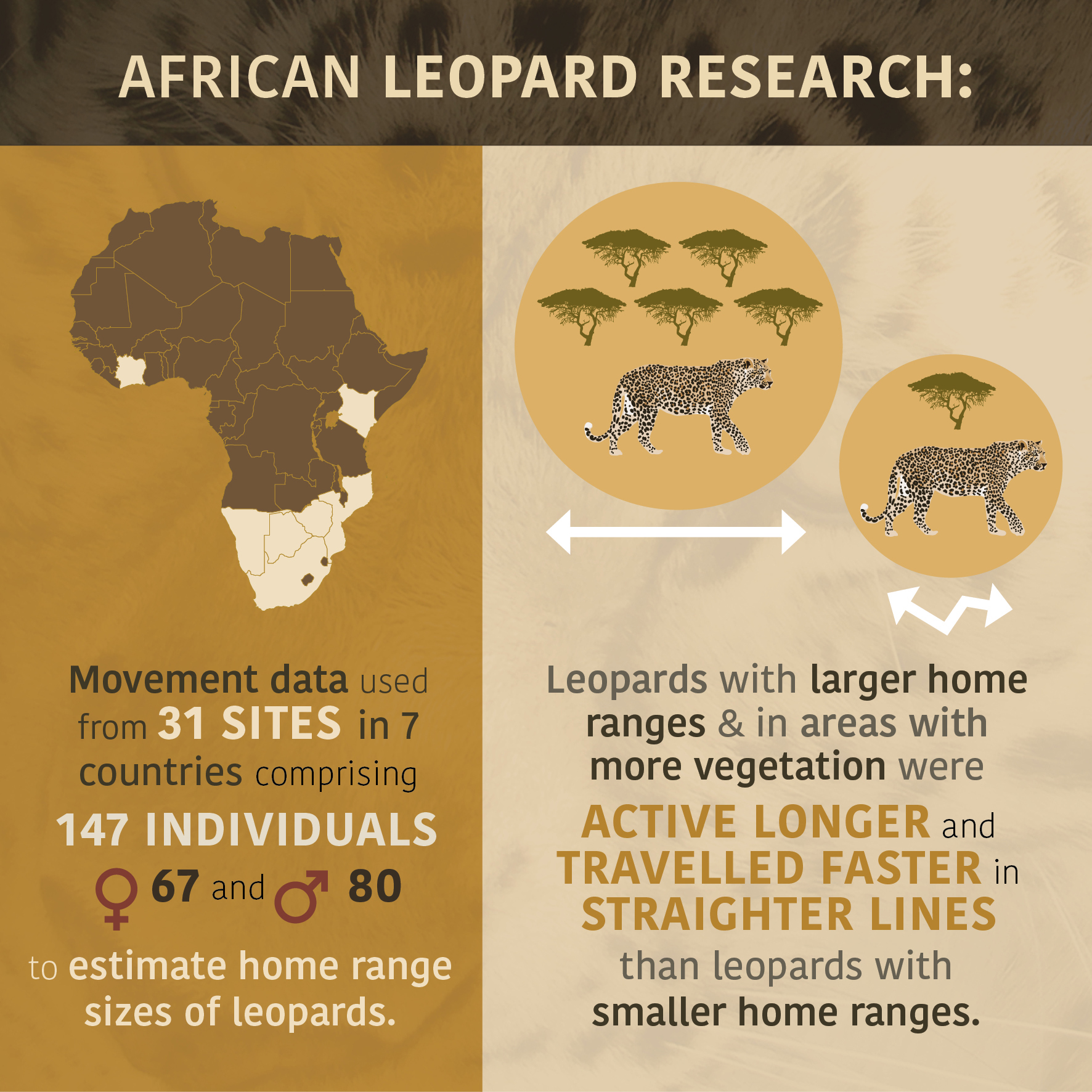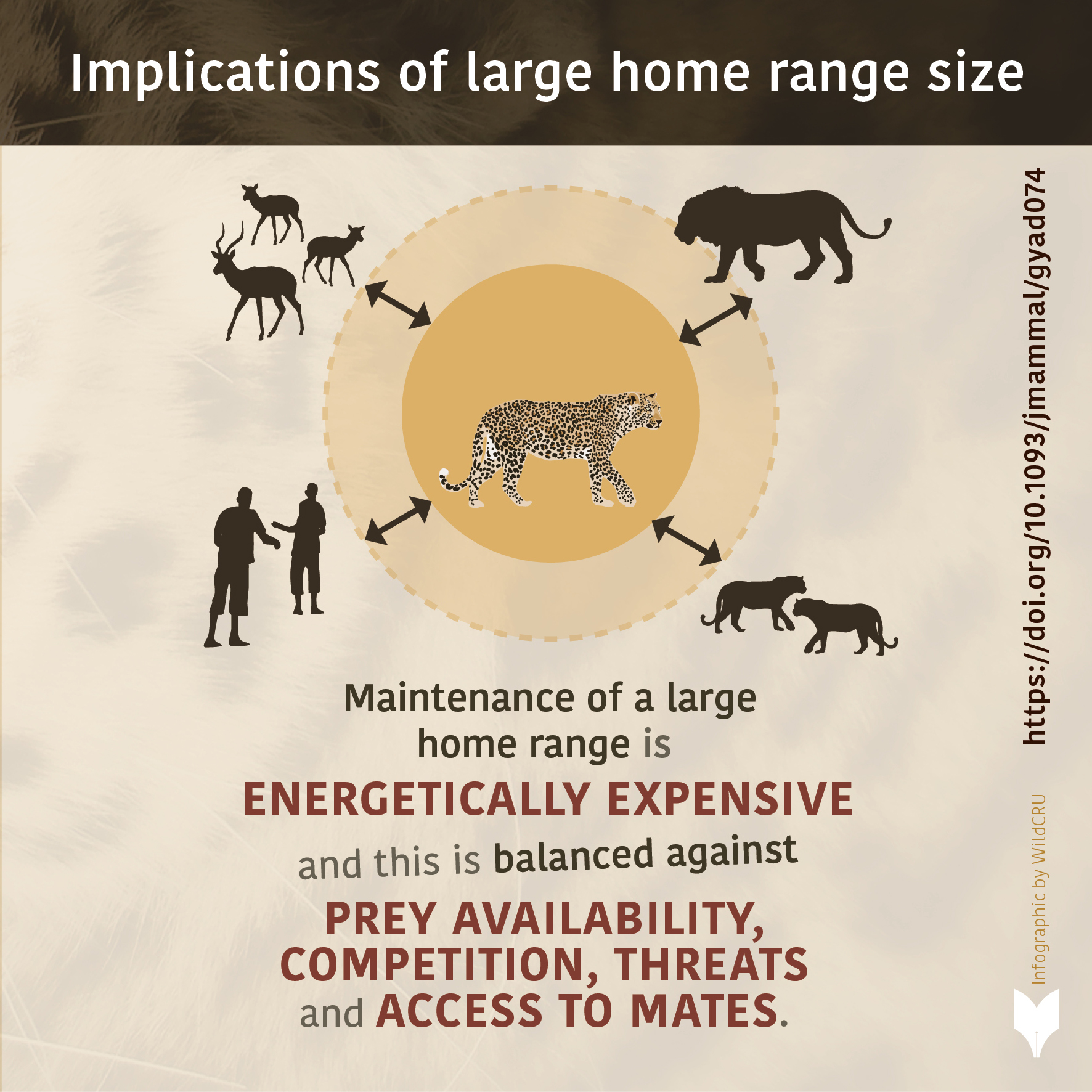News
Exploring factors influencing the home range size of African Leopards
Large carnivores provide important ecosystem and economic services that help maintain healthy and diverse natural environments. Yet these species face numerous threats across the world from habitat loss and fragmentation to prey reduction and direct persecution. Understanding large carnivore behaviour and use of space is often important to inform conservation – which ultimately benefits a wide array of flora and fauna as well as humans.
A new paper led by Daniel Parker, with co-authors including WildCRU’s Professor David Macdonald and Professor Andrew Loveridge, explores factors influencing the home range size of African leopards (Panthera pardus) – a predominantly solitary species. Like other large carnivores, leopards kill comparatively large prey relative to their metabolic requirements, so they generally have large home ranges and live in low population densities. Previous research has shown that 72% of the variability in leopard home range size is explained by the biomass of their preferred prey. In arid areas where prey are scarcer, leopard home ranges are generally more sizeable. Other factors influencing range size and leopard movement include competition with other species such as lion and spotted hyaena, interaction with other leopards, and persecution by humans.
To estimate leopard home range size in this study, movement data for 147 individual animals was obtained from 31 sites across Africa. This comprised 67 males and 80 females, enabling a detailed assessment of variations according to sex. The animal’s activity, speed and tortuosity (i.e. how straight a line they moved in) of travel were calculated, compared between seasons and across different habitats.
The findings revealed that leopards with larger home ranges spent more time being active, generally travelled faster, spent more time traveling, and in straighter lines than those with smaller home ranges. Thus, leopards in areas of lower prey densities not only have to travel further to find prey and other leopards, but they also likely expend more energy, and therefore need to eat more food, than in areas of lower prey densities.
The authors conclude that a combination of bottom-up (i.e., preferred prey availability), top-down (i.e., competition with other leopards), and reproductive (i.e., access to mates) factors likely drive variability in leopard home range sizes across Africa. Given that maintenance of a large home range is energetically expensive for leopards, it seems there is a complex evolutionary trade-off between satisfying basic resource requirements and preventing potentially dangerous encounters with other leopards and humans at some sites.
Daniel M Parker, Vilis O Nams, Guy A Balme, Colleen Begg, Keith Begg, Laura Bidner, Dirk Bockmuehl, Gabriele Cozzi, Byron du Preez, Julien Fattebert, Krystyna Golabek, Tanith Grant, Matt W Hayward, Ann-Marie Houser, Luke T B Hunter, Lynne A Isbell, David Jenny, Andrew J Loveridge, David W Macdonald, Gareth K H Mann, Nakedi Maputla, Laurie Marker, Quinton E Martins, Nkabeng Maruping-Mzileni, Joerg Melzheimer, Vera Menges, Phumuzile Nyoni, John O’Brien, Cailey Owen, Tim Parker, Ross Pitman, R John Power, Rob Slotow, Andrew Stein, Villiers Steyn, Ken Stratford, Lourens H Swanepoel, Abi Vanak, Rudi Van Vuuren, Bettine Wachter, Florian Weise, Chris C Wilmers, The implications of large home range size in a solitary felid, the Leopard (Panthera pardus), Journal of Mammalogy, 2023;, gyad074, https://doi.org/10.1093/jmammal/gyad074
See also:
https://www.facebook.com/groups/wildreserve and https://www.facebook.com/UniMpumalanga







